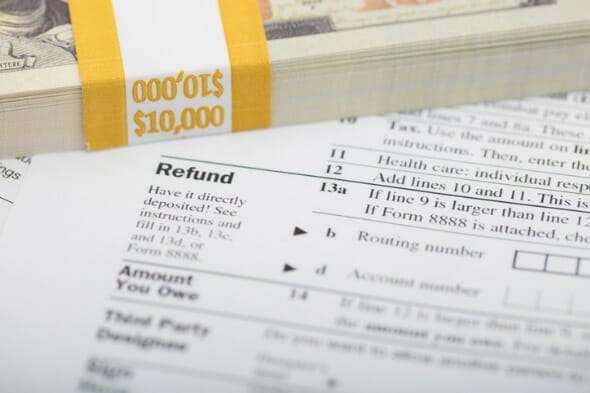Waiting on a tax refund that hasn’t arrived can be frustrating, especially if you’re counting on that money for bills or savings goals. While most refunds are issued quickly, even small issues can cause unexpected delays. Understanding how long the IRS typically takes to process refunds, and what can slow things down, can help you know when to wait and when to take action.
Go beyond taxes to build a comprehensive financial plan. Find a fiduciary financial advisor today.
How Long It Takes the IRS to Process a Tax Refund
In most cases, the IRS issues tax refunds within 21 days of receiving an electronically filed return. Paper returns usually take longer to process, often stretching several weeks or more. This timeline assumes there are no errors, missing information or additional reviews required.
Several issues can delay refund processing beyond the standard timeframe. Common causes include errors on the return, incomplete information or discrepancies that require manual review. Claims for certain credits, such as the Earned Income Tax Credit or Additional Child Tax Credit, can also extend processing times due to extra verification requirements.
How you file your return plays a significant role in how quickly your refund is processed. Electronic filing with direct deposit is generally the fastest option, while mailed returns and paper checks take longer. Choosing e-file and direct deposit can reduce delays tied to handling and processing.
The IRS may delay a refund if it needs to verify your identity or protect against potential fraud. This can happen if your return shows unusual activity or doesn’t match IRS records. While frustrating, these safeguards are designed to prevent unauthorized refunds and identity theft.
How Can I Track My IRS Refund?
If you are expecting a tax refund, you can check the status of your 2025 (filed in 2026) income tax refund by using the IRS Where’s My Refund tool. Taxpayers will need to input personal information, including their Social Security number or Individual Taxpayer Identification Number, as well as the filing status and the expected refund amount.
Taxpayers can also check their refund status on the agency’s mobile app IRS2Go. The app will also allow you to make tax payments and get free tax help (as long as you qualify).
Those getting tax refunds via direct deposit could get an “IRS TREAS 310” notification on their accounts, which identifies tax refunds processed through electronic payments. Note that “IRS TREAS 449,” indicates that your refund has been reduced to repay tax debt.
Reasons for a Tax Refund Delay
There’s no singular reason for a tax refund delay through the IRS. Instead, a multitude of different scenarios can affect how long it takes for you to get your refund back from Uncle Sam. For example, you may have made a mistake on your return, entered the wrong bank account information for the refund, filed early or several other situations. Below, we break down several common reasons why your tax refund could be delayed.
1. You Claim Certain Credits
If you file on the early side and claim the earned income tax credit (EITC) or the additional child tax credit (ACTC), you will have to wait a bit for a refund. According to the law, the IRS has to wait until mid-February to issue a refund to taxpayers who claimed either of those credits. President’s Day and bank processing times can slow down your refund further. The IRS says you can expect to receive your refund by Feb. 27 if you claimed either tax credit.
If the hold is because you filed before mid-February, there is no need to worry. The hold is not a result of mistakes or problems with your return. But if you filed later than that, the hold could also be because the IRS has questions or needs more information, in which case, you should receive a letter explaining what it requires.
If you claimed those credits, have been waiting weeks for a refund and have not received a letter from the IRS, you can check the status of your refund on the IRS website through its Where’s My Refund? tool.
2. Filing Early or Late
Early filers may have to wait for refunds. One reason for this is that the IRS may still be making changes to its processes. That could include updated security measures or process tweaks due to changes in the tax code. And if the IRS needs to update or make changes, it probably won’t make them until just before tax time.
Your refund could also face a delay if you file early in the tax season because this is a high-traffic time for the IRS. The same is true at the end of tax season. The majority of taxpayers file either as soon as they can or wait until close to the tax day deadline. Going through a high volume of returns will take time.
3. New Security Measures

Identity theft is a big threat in today’s world. To combat the threat, the IRS maintains strict security standards. Some security measures will cause the IRS to increase processing time for returns (and refunds).
If the IRS suspects that someone has attempted to steal your identity (by filing a fake return), this could hold up your return. You would then have to wait until the IRS completes any investigating and until it can ensure that you are who you say you are.
The IRS may also convert your refund from a direct deposit to a paper check. This will delay your refund but it is simply a security measure. It protects the IRS from sending money to a bank account it does not believe is yours.
Many state governments have also said that they will take longer to process tax returns because of new security measures. A state government may also work on a different timeline than the IRS. For example, Alabama historically has not started issuing refunds until March 1. The IRS starts issuing refunds in February. If you are trying to track your state refund, read this article on where your state refund is.
4. You Filed a Paper Return
As mentioned earlier, the IRS normally takes longer to process paper returns than electronically filed returns. That means you will wait longer for a refund—and even longer if you want your refund as a check. The IRS also takes longer to process a return and issue a refund if you file a paper return via certified mail.
Speaking of paper returns, you will need to file all amended returns (1040X) as a paper return. The IRS estimates the processing time for amended returns as somewhere between eight and 12 weeks.
Even if you file electronically, you will have to wait longer if you elect to receive your refund as a paper check. Sending a check through the mail also creates the possibility of the check getting lost or sent to the wrong address. That would delay your refund similar to the way sending a refund to the wrong bank account would.
5. Mistakes on Your Return
If you file an incomplete return or if you have any mistakes on your tax return, the IRS will spend longer processing your return. This will slow down any potential refund. Mistakes could include mathematical errors or incorrect personal information.
Using a tax filing service, such as TurboTax, will likely eliminate mathematical errors from your return. The software will do the math for you. However, it’s still possible to make a mistake if you are inputting any information manually For example, let’s say you manually input the information from your W-2. If you earned $50,000 over the year but you accidentally input $51,000, you may run into problems.
The IRS will contact you if there are any issues with your return. In some cases, the IRS will correct small mathematical errors. That could save you the work of having to file an amended return.
Incorrect personal information will also slow down your return. As an example, let’s say you file a joint return and incorrectly input your spouse’s Social Security number (SSN). The rest of the information on your return could be correct, but the IRS may not be able to confirm that because it can’t match your spouse’s SSN.
6. Incorrect Bank Info
Most taxpayers now receive refunds via direct deposit into a bank account. When you provide your account number and bank routing number, it’s important to double-check that the information is accurate. No one wants to miss out on a refund because it went to the wrong bank account.
If you entered the wrong account information, there are a few things you can do. In the case that the IRS hasn’t sent your refund yet, you can ask them to stop the direct deposit. Call the IRS toll-free at (800) 829-1040, any weekday between 7 a.m. and 7 p.m.
In the case that the IRS already sent the payment, you will need to contact the financial institution. If the institution can get the funds, it will return the refund to the IRS. The IRS will then issue your refund as a paper check. If the institution says it cannot get the funds back, you should file Form 3911, Taxpayer Statement Regarding Refund, with the IRS.
Form 3911 will allow the IRS to contact the financial institution on your behalf and attempt recovery of your refund. When you file the form, the IRS will initiate a trace. Banks have 90 days from the date of the initial trace to respond to the IRS’ request for information. However, a bank is not required to provide information to the IRS. If the bank doesn’t respond, your final option is to take civil action against the financial institution and/or the owner of the account into which your refund was deposited.
7. You Have Outstanding Debt
For certain types of debts, the IRS has the authority to garnish your tax refund. (Wage garnishment is the act of withholding money from you to put it toward something else.) Common reasons that the IRS will garnish your refund include
- You owe money for back taxes
- You defaulted on a federal student loan
- You owe money for child support
- You filed a joint return and your spouse has outstanding debt
If the IRS garnishes your refund, you will receive a notice explaining why it did so. If you don’t think you owe that debt, you will need to dispute it with the agency to whom the money was paid.
Bottom Line

There are several reasons why you could experience a tax refund delay. Some reasons won’t require any additional work on your part. This is the case if you claim certain credits or if you file at certain times. Filing a paper return or receiving your refund as a paper check will also slow things down.
Other reasons for delay might be that you made a mistake or omitted information. In this case, the IRS will send you a letter. If you requested a direct deposit and provided incorrect bank information, however, you will have to track the money down. In any case, the easiest way to check on your refund is through the IRS2Go app or website tool.
Tips for Making the Most of Your Refund
- If you receive a tax refund and want to make the most of it, consider speaking with a financial advisor to see how they would suggest investing it. Finding a financial advisor doesn’t have to be hard. SmartAsset’s free tool matches you with vetted financial advisors who serve your area, and you can have a free introductory call with your advisor matches to decide which one you feel is right for you. If you’re ready to find an advisor who can help you achieve your financial goals, get started now.
- If you do not have any pressing debts to pay off, you may want to put your refund right into the bank. In that case, look for a high-interest savings account. Getting the highest interest rate possible will make your money work for you.
- Another way to use your refund is by putting it toward retirement. That may not sound very fun but it’s important to ensure you can live your golden years doing whatever you want to do.
Photo credit: © iStock/LPETTET, © iStock/anyaberkut, © iStock/AntonioGuillem
